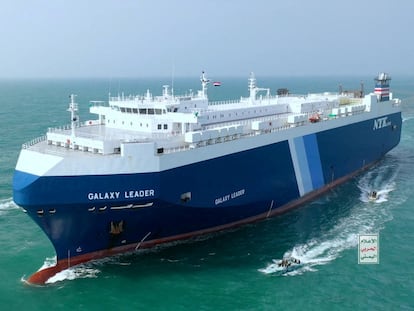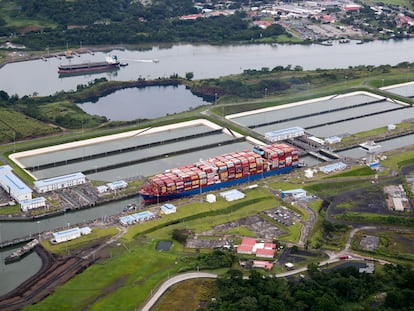A new storm hits the shipping sector, raising fears of inflation
The price of freight shipping has doubled in value since May. Experts warn that this will have a knock-on effect on consumer products: ‘This Christmas will be more expensive’


Global maritime trade is getting used to its new normal. The cost of shipping the huge, colorful containers that carry everything from sandals to electric vehicles has soared again amid the prolonged attacks on the Suez Canal, which has forced ships to take longer and more expensive routes. If at the end of 2023, when the Houthi militias began their first attacks on cargo ships linked to Israel, the industry was in “pre-alert,” now it appears to entering a new phase of uncertainty, which could have a direct impact on inflation.
The World Container Index, which is published weekly by maritime consultancy Drewry and measures the average price of shipping by sea, has climbed to $5,901 — a value not reached since the end of 2022. This index has more than doubled since the beginning of May. While the situation is still far from what was seen during the Covid-19 pandemic — with stratospheric prices that led to soaring inflation across the planet — experts are taking it for granted that the current spike in freight rates will be passed on to consumer goods in the coming months. If this impacts inflation, it could affect future decisions on interest rate cuts.
All eyes are on the 120-mile Suez Canal, which is responsible for 30% of global container trade. Between last November and mid-March, 45 drone attacks by Houthi militias were reported in the sea channel. In the worst-case scenario, if the conflict drags on for the rest of the year — which analysts see as increasingly likely — global inflation could rise by 5% annually, according to the OECD. JPMorgan is more cautious, and has predicted a rise of 0.7% in the first half of the year.
The price for transporting a container between the busiest deep-sea route — which links the ports of Shanghai and Rotterdam — has reached $8,056 per 40-foot container. This is five times what it was more than a year ago. The rise in prices is due to the fact that ships have been forced to take different routes. Many of the ships that used to sail through the Red Sea, now travel around the Cape of Good Hope in southern Africa — a route that lengthens the journey from Asia to Europe by between nine and 14 days. This change is also affecting other routes, such as the one from Rotterdam to New York, where freight costs have risen 150% in the last six months, coming in now at $6,835.
At stake is the future of a sector that is becoming increasingly important for the world economy: the semiconductor industry. The chip industry, which is needed today in all kinds of sectors — from weapons to household appliances — was hard hit by the shortages of these essential components. Although semiconductor supply chains have since recovered, fears of a possible Chinese invasion of Taiwan and the AI sector’s insatiable hunger for semiconductors could lead to another global chip shortage.
The spike in freight transport prices is good news for the big names in the shipping sector, which have seen their stocks surge. China’s COSCO is up 74% since January, Germany’s Hapag-Loyd is up 13% and Taiwan’s Evergreen — which was responsible for blocking the Suez Canal in 2022 — is up 21%. However, not all major companies are celebrating. The Danish group AP Moller-Maersk lost 16% in the last six months after reporting weak results in the last quarter (compared to the record-high figures of the pandemic) and lower forecasts for the coming months.
“A constant concern”
Jordi Espín, from the European Shippers’ Council, does not believe that the situation is going to improve in the short term. He predicts that the rise in freight costs will be passed on to consumer goods once the summer is over. “We will have a more expensive Christmas,” predicts Espín. According to the expert, two factors are making the situation even more unsustainable. Firstly, the expansion of trade routes is causing containers to build up in the main ports, he says, and this in turn, is causing serious problems for shipping companies when it comes to docking and unloading more goods. This scenario, in addition to the rise in transportation costs, is the perfect excuse for shipping companies to inflate rates, he says.
Óscar Calvo, CEO of JCV Shipping, a sea freight management company, adds that the increase in freight rates has also been driven by the rise in Chinese exports, which have increased by 10% in the first three months of the year. It has once again become common to see images of congested ports. In Singapore, which is home to the world’s second-busiest port and is a key cargo transfer hub between Asia and the West, delayed shipments rose 27% over the past months, compared to a year earlier, according to data from FourKites, a supply chain tracking platform.
Clarksons Research, a firm specializing in maritime traffic, is also concerned about the situation in commodity markets. The agency estimates that tanker arrivals of crude oil in the Suez Canal fell 25% in the first half of the year, and that the arrival of grain ships was 64% below last December’s traffic. The pressure in the Red Sea (added to the start of the hurricane season) has pushed the Brent Crude Oil — the benchmark used in Europe — to nearly $86 a barrel.
Ghosts of the past
This is not the first time that the deep-sea trade, popularized in the 1950s for its efficiency in transporting goods, has caused concern in world markets. The pandemic was the first big lesson the industry was forced to learn. The generous checks handed out in the United States to deal with the crisis boosted household spending, together with increased consumption of furniture and electronics, increased shipping traffic and shipping companies were not able to keep up with orders. This was compounded by a structural shortage of workers due to Covid-19. This crisis led to record-high freight rates and a wave of inflation across the world.
Logistically, there is less likelihood of a repeat of the bottlenecks of 2022, according to Niels Madsen, vice president of operations at Copenhagen-based Sea-Intelligence. Madsen points out that shipping companies have been busy building ships with more cargo capacity, thanks in large part to the huge profits they made during the pandemic. “New shipping fleets are absorbing the over-demand and lessening the impact of the container ship shortage,” says Madsen.
“A lot was learned from the pandemic,” Calvo adds. The expert points out that companies are no longer as exposed to disruptions in maritime trade because they have sought alternative suppliers in nearby areas and have increased supplies. However, he also warns that once the crisis in the Red Sea is over, it will take six months for the routes to stabilize. In other words, the situation is still far from under control.
Sign up for our weekly newsletter to get more English-language news coverage from EL PAÍS USA Edition
Tu suscripción se está usando en otro dispositivo
¿Quieres añadir otro usuario a tu suscripción?
Si continúas leyendo en este dispositivo, no se podrá leer en el otro.
FlechaTu suscripción se está usando en otro dispositivo y solo puedes acceder a EL PAÍS desde un dispositivo a la vez.
Si quieres compartir tu cuenta, cambia tu suscripción a la modalidad Premium, así podrás añadir otro usuario. Cada uno accederá con su propia cuenta de email, lo que os permitirá personalizar vuestra experiencia en EL PAÍS.
¿Tienes una suscripción de empresa? Accede aquí para contratar más cuentas.
En el caso de no saber quién está usando tu cuenta, te recomendamos cambiar tu contraseña aquí.
Si decides continuar compartiendo tu cuenta, este mensaje se mostrará en tu dispositivo y en el de la otra persona que está usando tu cuenta de forma indefinida, afectando a tu experiencia de lectura. Puedes consultar aquí los términos y condiciones de la suscripción digital.
More information
Archived In
Últimas noticias
There is as much life left to discover on planet Earth as that which is already known
Dozens presumed dead, around 100 injured in fire at Swiss Alps bar during New Year’s celebration
Is porn for women different from conventional porn? We spoke to those who make it
Cartagena de Indias is sinking: What can the city do to mitigate it?
Most viewed
- Reinhard Genzel, Nobel laureate in physics: ‘One-minute videos will never give you the truth’
- David King, chemist: ‘There are scientists studying how to cool the planet; nobody should stop these experiments from happening’
- Oona Chaplin: ‘I told James Cameron that I was living in a treehouse and starting a permaculture project with a friend’
- Sinaloa Cartel war is taking its toll on Los Chapitos
- The Interoceanic Train, the Mexican alternative to the Panama Canal










































